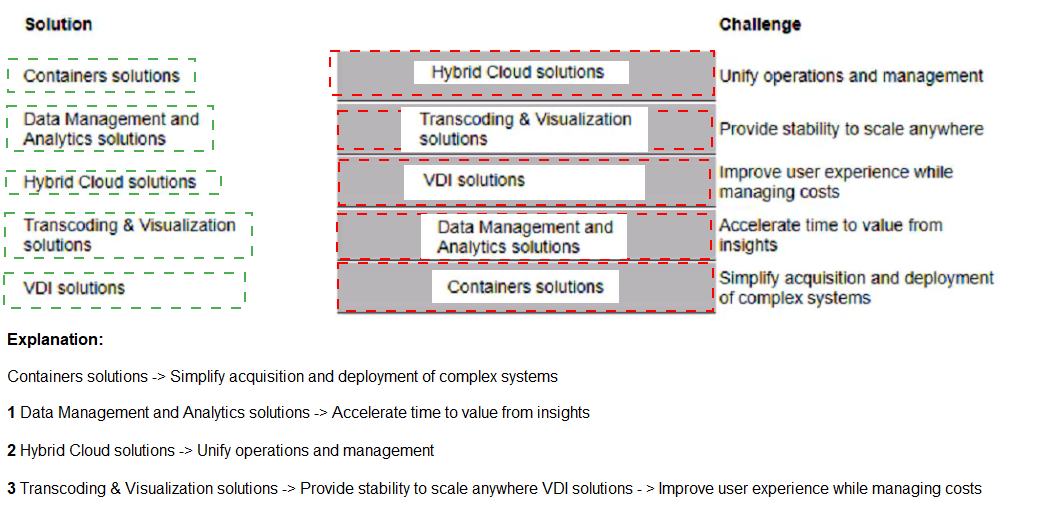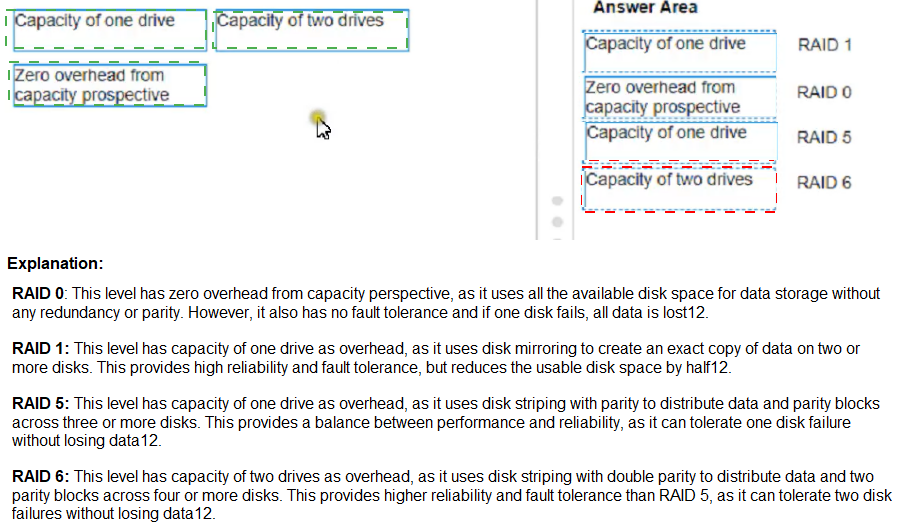Topic 2: Exam Pool B
Your customer wants to check the remaining life for solid-state drives in their DL345 Genl 0 Plus server. What can you use to find this information?
A. Integrated Management Log
B. Smart Storage Administrator
C. storage Management Utility
D. GreenLake Data Ops Manager
What tool should be used to input customer intent documents (CID) requirements?
A. One Config Advanced (OCA)
B. HPE NinjaSTARS
C. Solution Sales Enablement Tool (SSET)
D. HPE Storage STaTS Tool
You are preparing a presentation to explain the benefits of HPE GreenLake Cloud Services. Where would you find these presentation slides? (Select two.)
A. HPE Solution Sales Enablement Tool
B. HPE Products and Solutions Now
C. HPE Seismic
D. HPE CloudPhysics
E. HPE Product Bulletin
Your customer needs to accelerate the performance Of their DL380 Gen10 servers running workloads on more active cores at higher Clock frequencies. The customer wants to know if Core Boosting will help. What advice Should you provide?
A. It is only supported on ProLiant DL Gen11 servers.
B. It is a software solution and has performance limitations.
C. It is only supported on certain Intel processors.
D. It is an AMD technology so it is unavailable to them
Explanation:
Core Boosting technology uses a relaxed and optimized turbo profile that adapts the
processor to specific use cases, configurations, and environments. Core Boosting
processors take advantage of extra server power and thermal headroom provided by an
innovative HPE voltage regulator design and by cooling technologies. Consequently,
systems that have Core Boosting processors can alleviate common setbacks and
maximize processor computing power.
However, Core Boosting option is only supported in ProLiant Gen10 servers with certain
Intel processors1. The HPE ProLiant DL380 Gen10 server data sheet2 lists the supported
processors for Core Boosting as:
Intel Xeon Gold 6148 Processor (20 core, 2.4 GHz, 27.5 MB L3 cache)
Intel Xeon Gold 6154 Processor (18 core, 3.0 GHz, 24.75 MB L3 cache)
Intel Xeon Gold 6152 Processor (22 core, 2.1 GHz, 30.25 MB L3 cache)
Intel Xeon Platinum 8168 Processor (24 core, 2.7 GHz, 33 MB L3 cache)
Therefore, if your customer’s DL380 Gen10 servers are running workloads on more active
cores at higher clock frequencies, they can benefit from Core Boosting technology if they
have one of these supported Intel processors.
A customer who is new to HPE wants to refresh the hardware infrastructure for their VMware environment. Before meeting the customer, you need to perform an assessment to get a better of their environment Which HPE tool should you use?
A. OneView
B. CloudPhysics
C. GreenLake Quick Quote
D. InfoSight
Explanation:
CloudPhysics is a tool that provides a comprehensive assessment of VMware
environments and helps identify opportunities for optimization and modernization.
CloudPhysics can also generate a ready-to-order bill of materials for HPE solutions based
on the customer’s workload requirements.
The other options do not seem to be suitable for performing an assessment of a VMware
environment. OneView is a tool for managing HPE servers, storage, and networking2.GreenLake Quick Quote is a tool for creating quotes for HPE GreenLake services3.
InfoSight is a tool for monitoring and managing HPE storage systems.
You are explaining hardware health monitoring features Of an HPE ProLiant DL380 Geno Plus server. you need to snow how historical events can be viewed, including fan and power supply failures. Where can this information be found?
A. Integrated Management Log
B. ILO Event
C. HPE Data Ops Manager
D. Data Services Cloud Console
Explanation: Integrated Management Log (IML) is a feature that records hardware events such as fan and power supply failures on HPE ProLiant servers. The IML can be viewed through various methods, such as the iLO web interface, the iLO RESTful API, or the Smart Storage Administrator (SSA). The IML provides historical information about the server’s hardware health and helps with troubleshooting and analysis.
Your customer needs to consolidate data and add additional block-based storage to their man document management application. They nave five standalone servers with 10Gb networking. Which storage technology should you recommend?
A. Network File System
B. Storage Area
C. Direct Attached
D. Network Attached Storage
Explanation: According to IBM, a SAN is a dedicated network that provides access to consolidated, block-level data storage1. A SAN allows multiple servers to access shared pools of storage devices, such as disk arrays or tape libraries1. A SAN can help your customer consolidate data and add additional block-based storage to their main document management application.
A customer needs an open-source container orchestration system that supports cloudnative applications area provides support for containers with persistent storage at the same time. Which platform should you recommend?
A. Kubernetes
B. openstack Neutron
C. Hadoop
D. Hortonworks Data Platform
Explanation:
Kubernetes is an open-source system for automating deployment, scaling, and management of containerized applications. It groups containers that make up an
application into logical units for easy management and discovery. Kubernetes supports
cloud-native applications that are designed to run on distributed and dynamic
environments.
Kubernetes also supports containers with persistent storage by providing various options
such as:
Persistent Volumes: These are abstracted storage resources that can be
provisioned by administrators and consumed by users without worrying about the
underlying storage implementation.
Persistent Volume Claims: These are requests for storage by users that can be
dynamically or statically bound to Persistent Volumes.
Storage Classes: These are ways to describe different kinds of storage offered by
a cluster, such as SSD or HDD, performance or capacity, etc.
Volume Snapshots: These are point-in-time copies of Persistent Volumes that can
be used for backup or restoration purposes.
Container Storage Interface: This is a standard interface that allows Kubernetes to
communicate with various storage vendors and plugins.
Map the HPE platform and workload-oriented solutions with the customer’s challenge.


Which new feature is provided by the Storage Management utility v4?
A. autonomic
B. automatic file classification
C. automatic installation of new recommended firmware versions
D. easy switching of active firmware versions
Explanation: one of the topics covered in the module 4 of the Implementing HPE MSA Storage Solutions course is “Explain the firmware update process on MSA”. This suggests that the firmware update is a maintenance task that can be performed with the Storage Management utility v4.
Match the RAID level with its capacity overhead. (Each option may be used once, more than once, or not at all.)


What does an SSD wear Gauge define?
A. Remaining lifetime for the SSD drive
B. Type of technology used within the SSD drive
C. Type of interface used for the SSD drive
D. Maximum speed of the SSD drive
Explanation:
According to HPE, Smart SSD Wear Gauge is a feature that provides an estimate of the
remaining useful life of an SSD drive based on its usage patterns1. It can help you monitor
the health and performance of your SSD drives and plan for replacement or upgrade when
needed1.
| Page 3 out of 9 Pages |
| Previous |